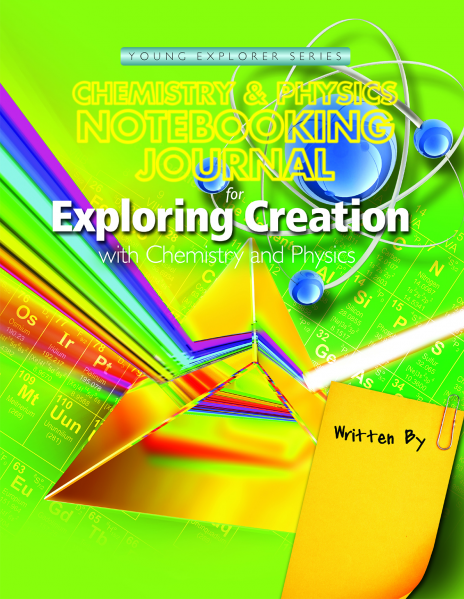Apologia Educational Ministries has many superb resources for learning, including science, Bible, history, and language arts. We received Exploring Creation with Chemistry and Physics and the Exploring Creation with Chemistry and Physics Notebooking Journal. I used them with Paige, who is in sixth grade.
The chemistry and physics textbook is a hardcover book geared towards children in grades K through 6 and retails for $39.00. There are 14 separate topics spread across this 280-page book. Some of the topics are matter, atoms, compounds, mixtures, mechanics, friction, energy, sound, light, heat, electricity, magnetism, and machines.
The notebooking journal we used and which is pictured here is a spiral-bound book for upper-elementary grades and retails $24.00. There is another journal, the junior notebooking journal, which is for early-elementary grades and is $24.00 as well.
We have used Apologia's science curricula for years: Botany, Astronomy, Swimming Creatures, etc., and have always loved it. This was the first year we used the notebooking journal.
As soon as we received the book, we started using it. The science concepts are taught so that even young children can understand them, but the book seems cluttered. There is a lot going on on each page. Since the book is appropriate for all elementary-aged children, some things are worded so that the younger children are engaged, i.e., things are repeated to get a point across, rhetorical questions are asked, silly comments are made. Those things, however, are below the level of a sixth grader. They do not detract from the learning, though.
There are sections in each chapter called, "Try This!" Some are games; some are experiments. We did not do each one since there are so many of them. They are set apart from the rest of the text inside a blue box. Inside the box is a paragraph or two of instructions. I don't know if it was the fact that there were so many Try This! sections or the fact that they were cluttered, but I felt overwhelmed by them. It would have been easier, for me, if they were subtitled with words like 'games' or 'experiment' and set up in an outline form.
There are beautiful and interesting images and illustrations throughout the book that helped Paige understand what she was learning. We liked the snowflake pictures and the drawings of gas molecules heating up and then coming together to form rain—very cute!
The notebooking journal has a syllabus in the front of it, which we followed. Every other day or every third day, there is work to do in the journal after reading from the text. Paige did not enjoy having work to do, but I was glad for the journal. It provided structure and a means to gauge her learning.
At the beginning of each section, there are a few pages on which she could take notes. There is a crossword puzzle and some copywork pages which include a page for printing a verse and a page for cursive writing. Each lesson has a hands-on project (mini-book, wheel, envelopes) and additional experiments. The last part of each lesson in the journal has a page or two of questions to see what she remembered. Most of the time she was able to recall the information without having to look back in the book to find it.
In the back of the textbook, there is a supply list for each lesson and an answer key for all of the "What Do You Remember?" sections.
What I liked:
*It is written with a Christian worldview.
*It is easily understood but not dumbed down.
*There are a lot of different activities to enhance learning.
*The journal is a super resource!
*There are great illustrations.
What I didn't like:
*It is very wordy without significant section breaks.
*The Try This! sections are overwhelming.





No comments:
Post a Comment